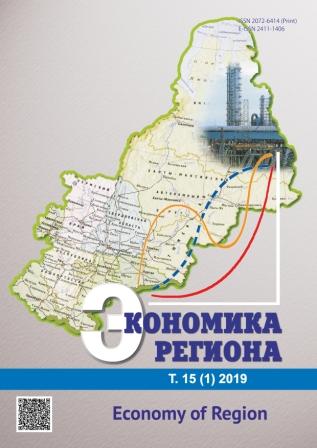Распределение городов в федеральных округах России: тестирование закона Ципфа
Distribution of Cities in Federal Districts of Russia: Testing of the Zipf Law
Author(s): Inna ManaevaSubject(s): National Economy, Human Geography, Rural and urban sociology, Socio-Economic Research
Published by: Институт экономики Уральского отделения Российской академии наук
Keywords: Zipf low;“rank-size”;Pareto index;city;federal district;city size;population;interregional differentiation;distribution of cities;territorial distribution;
Summary/Abstract: At the modern stage of globalization pressures, imbalance in the distribution of cities in territorial space poses a threat to Russia’s economic development and social stability, which actualizes economic research on this issue. The purpose of the article is to analyze the distribution of cities within the boundaries of federal districts with the application of the Zipf law. I have chosen this law as it allows connecting the population of the city with its place in the hierarchy of the urban systems in regions, federal districts and the country, in general. The Zipf law holds if the distribution of the population is uniform. The information base is the data of the Federal State Statistics Service. For the study, I have formed a sample of cities for each Federal District. This sample included 10 most populous cities by 2015. The hypothesis about the lognormal distribution of cities within the borders of the Russian federal districts is tested using the method of least squares. The calculations determined the estimated parameter K in the range from 0.6 to 1.4, which demonstrates the uneven distribution of cities within the borders of the federal districts of Russia (the exception is Volga Federal District K = 1). In the Central Federal District, Northwestern Federal District and Ural Federal District, the population is concentrated in large cities: Moscow, St. Petersburg and Ekaterinburg. In the North Caucasian Federal District, Privolzhsky Federal District, Siberian Federal District and Far Eastern Federal District, the population is disproportionately dispersed. In the territory of Russia, there is no intermediate group of cities with the population from 2000 to 5000 thousand people. The identification of the peculiarities of the distribution of cities within the borders of the federal districts of Russia is necessary for the development of scientifically substantiated recommendations of social and economic policies. The conducted research is a stage in the development of methodological tools for choosing the location of industrial production in the territories and for determining the optimal size of a city.
Journal: Экономика региона
- Issue Year: 15/2019
- Issue No: 1
- Page Range: 84-98
- Page Count: 15
- Language: Russian

